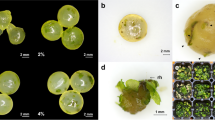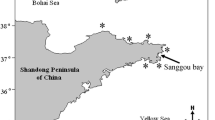Abstract
Sargassum swartzii is economically exploited in India for alginate production. Indiscriminate harvesting of S. swartzii in natural beds leads to fast depletion. For sustainable utilization of this alga, it is inevitable to undertake its mass cultivation. Therefore, investigations were undertaken to develop a technology that can boost cultivation of this important species. An attempt was made to optimize the culture conditions for developing zygote-derived germlings for artificial seed production through vegetative parts such as vesicles and tertiary leaves. Vesicles and tertiary leaves (n = 90) were subjected to a range of irradiances (05, 25, and 45 μmol photons m−2 s−1), salinity (15, 20, 25, 30, 35, 40, 45, 50, and 55 psu), and photoperiod (8:16, 10:14, 12:12, 14:8, and 16:8-h (L/D) regimes under 30-day culture. Maximum regeneration (%) of receptacle from vesicles and tertiary leaf was observed at an irradiance of 45 μmol photons m−2 s−1, 35 psu salinity, and 12:12-h (L/D) photoperiod which appears to be the most optimal condition. Variations in receptacle regeneration through vesicles and tertiary leaves were highly significant under different irradiances, salinities, and photoperiods (p < 0.05), and there were no significant differences between % regeneration of vesicles and tertiary leaves (p > 0.05). Germlings development followed the eight nuclei, one egg pattern which is quite common in the Sargassaceae. Within a day, multicellular germlings were developed with a bunch of unicellular rhizoids from fertilized oospores through repeated cell divisions. These findings confirmed that vesicles and tertiary leaves can be used as seed stock for the development of artificial seed production in S. swartzii as they contain primordial tissue for receptacle development.





Similar content being viewed by others
References
Appa Rao D, Padal SB, Subbarangaiah G (2014) Effect of environmental factors on oospore shedding and diurnal periodicity in Sargassum vulgare C. Agardh. along the Visakhapatnam coastline, east coast of India. Sch Acad J Biosci 2:687–695
Bird NL, McLachlan J (1976) Control of formation of receptacles in Fucus distichus L. subsp. distichus (Phaeophyceae, Fucales). Phycologia 15:79–84
Bold HC, Wynne MJ (1978) Introduction to the algae. Prentice Hall, New Jersey
Cao SQ, Zhang ZY, Wang GS, You XC, Liu HY (2008) Indoor artificial seeding of seaweed Sargassum muticum. J Dalian Fish Univ 23:359–363
Chauhan VD, Krishnamurthy V (1971) Ecology and seasonal succession of Sargassum swartzii (Turn.) C.Ag. in Indian waters. Phykos 10:1–11
De Wreede RE (1978) Growth in varying culture conditions of embryos of three Hawaiian species of Sargassum (Phaeophyta, Sargassaceae). Phycologia 17:23–31
Fletcher RL, Fletcher SM (1975) Studies on the recently introduced brown alga Sargassum muticum (Yendo) Fensholt I. Ecology and reproduction. Bot Mar 18:149–156
Hales JM, Fletcher RL (1989) Studies on recently introduced brown alga Sargassum muticum (Yendo) Fensholt. IV. The effect of temperature, irradiance and salinity on germling growth. Bot Mar 32:167–176
Hales JM, Fletcher RL (1990) Studies on recently introduced brown alga Sargassum muticum (Yendo) Fensholt. V. Receptacle initiation and growth, and gamete release in laboratory culture. Bot Mar 33:241–249
Holdt SL, Kraan S (2011) Bioactive compounds in seaweed: functional food applications and legislation. J Appl Phycol 23:543–597
Hwang EK, Park CS, Baek JM (2006) Artificial seed production and cultivation of the edible brown alga, Sargassum fulvellum (Turner) C. Agardh: developing a new species for seaweed cultivation in Korea. J Appl Phycol 18:251–257
Kerrison P, Le HN (2016) Environmental factors on egg liberation and germling production of Sargassum muticum. J Appl Phycol 28:481–489
Li F, Yu S, Mao Y, Ye N (2010) Regeneration of germlings and seedlings development from cauline leaves of Sargassum thunbergii. J Dev Biol Tiss Eng 2:14–17
Noormohammadi Z (2013) Bayesian analysis of species relationship in genus Sargassum: Oman sea and Persian Gulf. Int J Plant Anim Env Sci 3:268–278
Oza RM, Zaidi SH (2001) A revised checklist of Indian marine algae. Central Salt & Marine Chemicals Research Institute, Bhavnagar, India, 286 pp
Pang SJ, Gao SQ, Sun JZ (2006) Cultivation of the brown alga Hizikia fusiformis (Harvey) Okamura: controlled fertilization and early development of seedlings in raceway tanks in ambient light and temperature. J Appl Phycol 18:723–731
Pang SJ, Liu F, Shan TF, Gao SQ, Zhang ZH (2009) Cultivation of the brown alga Sargassum horneri: sexual reproduction and seedling production in tank culture under reduced solar irradiance in ambient temperature. J Appl Phycol 21:413–422
Raju PV, Venugopal R (1971) Appearance and growth of Sargassum plagiphyllum (Mert) C. Ag on a fresh substratum. Bot Mar 14:36–38
Steen H (2004) Effect of reduced salinity on reproduction and germling development in Sargassum muticum (Phaeophyceae, Fucales). Eur J Phycol 39:293–299
Subba Rao PV, Mantri VA (2006) Indian seaweed resources and sustainable utilization: Scenario at the dawn of a new Century. Curr Sci 91:164–174
Subbarangaiah G, Narasimha Rao GM, Deepthi Lavanya K (2012) Effect of environmental factots on oospore shedding in Sargassum ilicifilium (Turner) C Agardh. J Albal Biomass Utiln 3:57–64
Sukumaran S, Kaliaperumal N (2000) Oospore shedding in Sargassum wightii (Greville) J. Agardh and Turbinaria conoides (J. Agardh) Kuetzing at different environmental factors. Seaweed Res Utiln 22:209–218
Terry LA, Moss BL (1980) The effect of photoperiod on receptacle initiation in Ascophyllum nodosum (L.) Le Jol. Br Phycol J 15:291–301
Umamaheswara Rao M (1969) Seasonal variations in growth, alginic acid and mannitol contents of Sargassum wightii and Turbinaria conoides from the Gulf of Mannar, India. Proc.7th Int. Seaweed Symp. pp 579–584
Umamaheswara Rao M, Kaliaperumal N (1976) Some observations on the liberation and viability of oospores in Sargassum wightii (Greville) J. Agardh J Ag Indian J Fish 24:232–235
Umamaheswara Rao M, Kaliaperumal N (1987) Effect of thermal stress on spore shedding in some red alage of Visakhapatnam coast. Ind J Mar Sci 16:201–202
Vadas RL (1972) Ecological implications of culture studies on Nereocystis leutkeana. J Phycol 8:196–203
Veeragurunathan V, Eswaran K, Malarvizhi J, Gobalakrishnan M (2015a) Cultivation of Gracilaria dura in the open sea along the southeast coast of India. J Appl Phycol 26:2353–2365
Veeragurunathan V, Eswaran K, Saminathan KR, Mantri VA, Malar Vizhi J, Ajay G, Jha B (2015b) Feasibility of Gracilaria dura cultivation in the open sea on the Southeastern coast of India. Aquaculture 438:68–74
Xie EY, Liu DC, Jia C, Chen XL, Yang B (2013) Artificial seed production and cultivation of the edible brown alga Sargassum naozhouense Tseng et Lu. J Appl Phycol 25:513–522
Yuan YD, Zhang SH, Sun AF, Liu HY (2006) Trial culture of Sargassum thunbergii with long line rafts. Trans Oceanol Limnol 2:125–128
Zhao Z, Zhao F, Yao J, Lu J, OP A jr, Duan D (2008) Early development of germlings of Sargassum thunbergii (Fucales, Phaeophyta) under laboratory conditions. J Appl Phycol 20:925–931
Zou JX, Li YQ, Liu YX, Zhang TW, Wang YM (2005) Studies on biological features and raft culture of Sargassum thunbergii. Shangdong Fish 22:25–28 (in Chinese)
Acknowledgments
Authors are highly thankful to JAPH reviewers for giving valuable comments to improve the quality of our manuscript. A financial support was provided by the Council of Scientific and Industrial Research (CSIR), New Delhi, under in-house project (OLP-0075). Authors expressed their sincere thanks to Dr. K. Eswaran, SIC, CSMCRI-MARS, Mandapam, Dr. K.H. Modi, former Discipline chair, Discipline of Marine Biotechnology and Ecology, CSMCRI, Bhavnagar, and Dr. C. R. K. Reddy, Discipline chair, Discipline of Marine Biotechnology and Ecology, CSMCRI, Bhavnagar, for their strong encouragement. Authors expressed their sincere thanks to Dr. SWA Naqvi, former Director, and Dr. Amitva Das, Director, CSMCRI, Bhavnagar, for providing facilities to carry out the experiments. Authors extended their sincere thanks to Mr. Neimia, President, SNAP alginate, Ranipate, Tamilnadu, for his valuable information of collection of Sargassum and alginate production details. Authors are also grateful to Dr. Vaibhav A. Mantri, Sr. Scientist, CSMCRI, Bhavnagar, and Dr. M. Ganeasan, Sr. Scientist, CSMCRI-MARS, Mandapam, for their critical review for strengthening the manuscript. This contribution has CSIR-CSMCRI PRIS registration number 019/2016.
Author information
Authors and Affiliations
Corresponding author
Rights and permissions
About this article
Cite this article
Kavale, M.G., Veeragurunathan, V. Development of zygote for seed production of Sargassum swartzii in India. J Appl Phycol 28, 2875–2882 (2016). https://doi.org/10.1007/s10811-016-0844-1
Received:
Revised:
Accepted:
Published:
Issue Date:
DOI: https://doi.org/10.1007/s10811-016-0844-1




